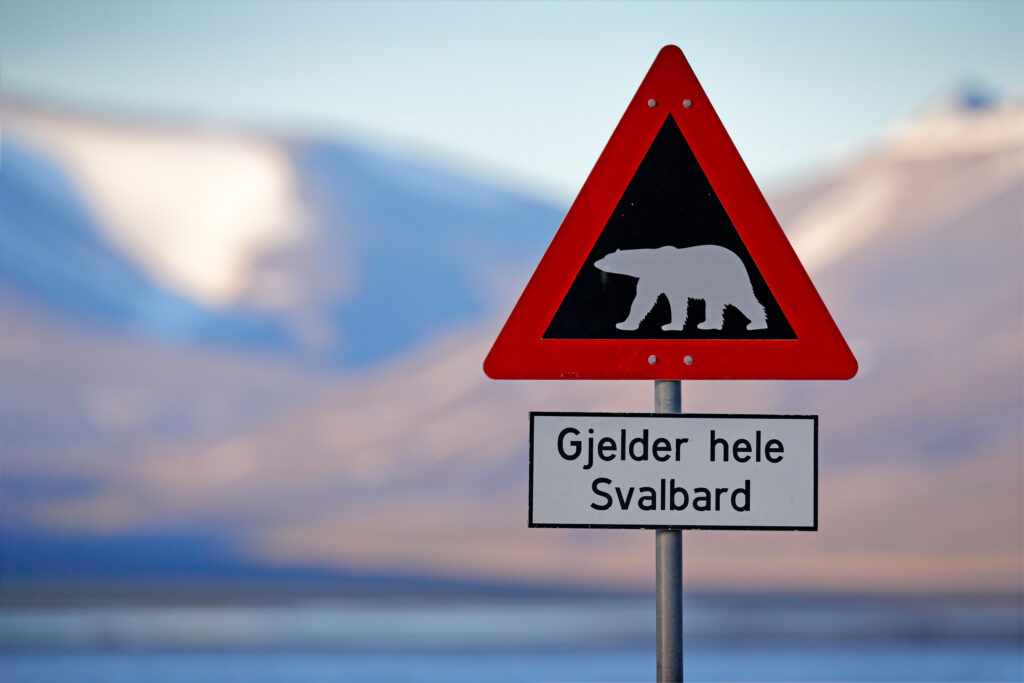Is it safe to visit Svalbard? A Visitor’s Guide to Safety In The Arctic
Table Of Contents
- It is considered safe to visit Svalbard with the proper preparation. Each year, over 100,000 people visit Svalbard, and the vast majority of visits are trouble-free.
- Due to its harsh climate and remote location, just 800km from the North Pole in the High Arctic, Svalbard requires more planning, awareness and safety rules than in other destinations.
- Expedition cruises and guided tours offer the safest way to see what Svalbard has to offer. Highly trained expedition teams experienced in the local area are there for your safety.
- Whilst there are added risks in travelling in Svalbard, such as cold temperatures, polar bears and limited medical facilities, these can be mitigated with thorough planning and joining a professionally led tour.
Is the Arctic archipelago of Svalbard with its untouched wilderness calling you? A question we are commonly asked by people planning their trip is, “Is Svalbard safe to visit? “The short answer is yes, but there are conditions.
In this article, I share my 15 years of experience travelling in the Svalbard islands to highlight all you need to know to stay safe and have an enjoyable and memorable experience in one of the greatest landscapes on Earth. It covers:
- Trip planning
- Polar bear and wildlife safety
- Weather and environment
- Safety equipment
- Medical and health considerations
Let’s dive in.
Planning Your Svalbard Trip
In Svalbard, and unlike mainland Norway, it is not possible to go off on your own due to the dangers posed by polar bears, the ice conditions and the vast wilderness. Instead, you must either join land-based tours such as hiking, dog sledding or snowmobiling or join an expedition cruise to explore the archipelago.
- It is not possible to leave the town limits of Longyearbyen on your own without a guide carrying polar bear protection. Guides carry firearms at all times.
- Expedition cruises offer an excellent way to see Svalbard during the summer months and encounter wildlife such as polar bears safely and responsibly.
- Expedition cruises are led by a highly experienced and qualified guide team that carries polar bear protection for your safety.
- Planning your trip is essential as the best expedition cruises and tours are often booked up months in advance.
At Polar Escapes, we are experts in travelling to Svalbard and offer the most extensive range of Svalbard Cruises and Tours. If you need some firsthand advice from people who have been there, please don’t hesitate to get in touch.

Polar Bear Safety
The most talked about safety concern about Svalbard is polar bears. Polar bears can be potentially dangerous to humans if encountered on land, particularly if a bear has cubs or is suffering from malnutrition.
The risk to tourists from polar bear danger is mitigated by highly trained professional guides who are experienced at avoiding polar bear encounters and equipped with polar bear deterents.
The best way to see polar bears in the wild is on an expedition cruise in Svalbard. Viewing polar bears from the ship or the Zodiacs offers the safest way to see these majestic creatures in the wild.
Before a shore landing, guides will carefully scout out the coast to ensure the landing site is free of polar bears. During the landing, lookouts keep a vigilant eye. If a polar bear is spotted, guests are immediately taken back to the Zodiacs, and the shore landing is cancelled. This happened to me on one occasion and at no time was the polar bears or any of the guests in danger. The guides acted quickly and professionally.
Guides leading tours outside of Longyearbyen are equipped with the necessary equipment and deterrence for polar bear protection. They are highly trained in polar bear protection and deterrence.
New rules that came into effect in 2025 have increased safety measures. A minimum distance of 300 meters (July 1 to February 28) and 500 meters (March 1 to June 30) must now be kept from polar bears, which provides extra protection for both wildlife and visitors.
Other wildlife can also pose a risk. Never approach walruses, which are equipped with giant tusks, or Arctic foxes, which have the potential to carry rabies in the Arctic.
Safety Tips:
- Always follow the safety instructions from your guide. If they ask you to leave an area due to a polar bear threat, do so immediately.
- Never venture out into the wilderness in Svalbard on your own without the appropriate training and polar bear deterrents.
- Never attempt to approach a polar bear or any other wildlife.
- Respect local wildlife laws. It is illegal to hunt, lure, pursue, feed or disturb a polar bear.

Environmental and Weather Hazards
Svalbard has an Arctic climate, and the environment is both magical and potentially harsh even during the summer months. The weather conditions can change fast if the wind picks up. It is essential to:
- Travel with a local tour operator or expedition cruise operator experienced in the local conditions, including glacier and avalanche risks.
- Dress for the weather with several layers of clothing. Depending on the time of year you are visiting and the type of expedition you are joining, you will need to make sure you are appropriately dressed. At the time of booking, we will provide you with a packing list. Warm socks are a must!
- Wear sunglasses and use a high SPF 50 sunscreen.
- Keep warm and dry at all times to prevent hypothermia.
- Only undertake activities that are within your fitness level and capabilities.
Medical and Health Considerations
Due to its remote location, medical facilities in Svalbard are limited, and advanced medical care can be hours or potentially days away. There is a basic public hospital in Longyearbyen.
Expedition cruise ships have a doctor on board who can deal with minor injuries and issues. Svalbard has a search and rescue helicopter, so you must have emergency evacuation insurance.
Rabies is a potential risk in Svalbard as Arctic foxes can carry it in the area. Never approach or touch an Arctic fox.
- It is highly advisable to get a check-up with your physician or GP before travelling to a remote place such as Svalbard.
- If you are on a prescription, bring enough medicine with you for the entirety of your trip and enough to cover any potential delays.
- Ensure you are in good physical condition. Consult us before travel if you have a condition that could affect your health.
- Carry comprehensive medical insurance that covers emergency evacuation from Svalbard.
Mandatory Safety Equipment and Guidelines
When travelling outside settlements in Svalbard, specific safety equipment is required by law. This includes firearms or flare guns for polar bear deterrence, communication devices, reflective vests and survival equipment. Be careful when moving outside the settlements, and preferably be accompanied by a local guide, as recommended, emphasising the importance of professional guidance.
Most tourists experience Svalbard through organised tours and expeditions, which come with experienced guides, proper safety equipment and established protocols for wildlife encounters. These professional operations have excellent safety records and provide the expertise necessary for safe Arctic travel.
Best Practices for Safe Travel In Svalbard
At Polar Escapes, all our expeditions are led by established tour operators with extensive Arctic experience. They provide the proper equipment, experienced nature guides familiar with local conditions, terrain and established emergency protocols. They also handle the complex logistics of polar bear safety measures and navigation in challenging situations.
Timing Your Visit
Different seasons in Svalbard have different risk profiles. Summer has more daylight, milder temperatures and generally easier travel conditions, but this is also when polar bears are most active on land.
Winter temperatures are more extreme, but the season offers experiences like the Northern Lights. There are challenges such as the 24 hours of darkness, snow conditions and strong winds, which make it feel colder than the measured temperature. From mid-February, the sun returns and snowmobile tours begin. See our guide best time to visit Svalbard for more detail on each month.
New 2025 Safety Rules
Recent regulations have increased visitor safety and environmental protection. From January 1, 2025, the Norwegian government introduced rules for cruising activities, especially polar bear viewing. These measures include stricter guidelines for wildlife viewing distances and limitations on access to sensitive areas.
Landings in protected areas will be prohibited, except for 43 designated landing sites. Passenger limits of 200 will apply in all protected areas to ensure better crowd management and reduced environmental impact while maintaining safety standards. You can read the full changes of the Svalbard Environmental Act on the AECO website.
Before You Travel To Svalbard
- Book all your travel before you depart for Svalbard. During the summer, flights, expedition cruises, and private tours, as well as accommodation in the main town of Longyearbyen, are often fully booked months in advance.
- Check if you need a Schengen visa to enter the Schengen area when you pass through Oslo. See Svalbard visas for more info.
- Get a medical check-up to ensure you are in good health to visit a remote area with limited medical assistance.
- Choose activities and tours that match your physical fitness and abilities. Most people visiting Svalbard opt for an expedition cruise as it provides an easy form of travel with no special ability required.
- Check the travel advice of the Foreign Office and Visit Svalbard for more information.
The Reality Check
While risks do exist as with any travel destination, Svalbard has an outstanding safety record for tourism. The combination of local operators, modern safety equipment, established protocols and new rules creates a framework to explore Svalbard.
I have travelled in Svalbard on multiple occasions, seen over 20 polar bears in the wild and at no time have I ever perceived myself to be in an unsafe situation.
The key to safe travel in Svalbard is to respect the environment, understand the risks and rely on professional expertise. Independent travel outside settlements requires extensive preparation, proper equipment and local permits, making guided experiences the preferred option for most visitors.
Fatal polar bear attacks, while tragic when they happen, are statistically incredibly rare given the number of visitors each year.
Svalbard Safety Conclusion: Key Takeaways
- Svalbard is safe to visit for well-prepared travellers who respect the Arctic environment and follow safety guidelines.
- Professional local tour operators and guides are essential for navigating the vast wilderness and the risks of polar bears.
- Polar bear safety measures, including carrying deterrents and maintaining safe distances, are strictly enforced.
- Proper clothing with several layers, a fleece, warm socks, and protective gear are vital due to harsh and rapidly changing weather conditions.
- Medical facilities are limited; comprehensive health preparation and insurance are highly recommended.
- Booking tours, cruises, and accommodation well in advance is essential due to high demand.
Travel To Svalbard With Polar Escapes
At Polar Escapes, we specialise in travelling to the polar regions, including Svalbard. Each year, we ensure numerous safe expeditions for our guests and help them navigate the challenges of travelling in the Arctic.
If you are looking to experience the far north, why not get in touch to get some firsthand expert advice?
Most emails are boring.
Ours are cool.




